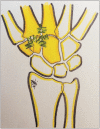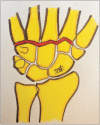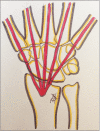Acute Dislocation of the Metacarpal-Trapezoid Joint
- PMID: 27247751
- PMCID: PMC4870329
- DOI: 10.4055/cios.2016.8.2.223
Acute Dislocation of the Metacarpal-Trapezoid Joint
Abstract
The trapezoid metacarpal dislocation is a rare event. In the literature, it is found in case reports. This injury is caused by direct or indirect high energy trauma. In most cases, the dislocation is dorsal and is difficult to reproduce because the joint is not very mobile. Given the low incidence and little evidence supported in the literature regarding the management, this injury can be treated by open or closed reduction; however, it has been published that most authors use Kirschner wire fixation with good results. Here we present our experience in the management of a male patient with acute trapezoid metacarpal dislocation handled with a splint with good functional results at 6 weeks.
Keywords: Carpometacarpal joints; Dislocations.
Conflict of interest statement
Figures







References
-
- Lewis HH. Dislocation of the second metacarpal: report of a case. Clin Orthop Relat Res. 1973;(93):253–255. - PubMed
-
- Carneiro RS, Rancatore E. Dorsal dislocation of the index carpometacarpal joint. J Emerg Med. 2000;18(1):21–22. - PubMed
-
- Pack DB, Grossman TW, Resnik CS, Gillespie T. Isolated volar dislocation of the index carpometacarpal joint: a unique injury. Orthopedics. 1995;18(4):389–390. - PubMed
-
- Mehara AK, Bhan S. Rotatory dislocation of the second carpometacarpal joint: case report. J Trauma. 1993;34(3):464–466. - PubMed
-
- Nakamura K, Patterson RM, Viegas SF. The ligament and skeletal anatomy of the second through fifth carpometacarpal joints and adjacent structures. J Hand Surg Am. 2001;26(6):1016–1029. - PubMed
Publication types
MeSH terms
LinkOut - more resources
Full Text Sources
Other Literature Sources
Medical

